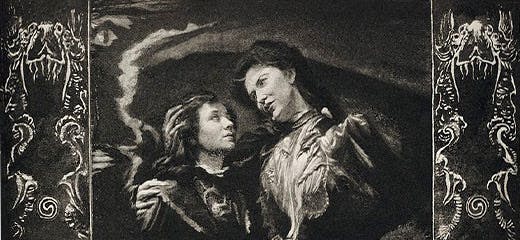
THE TURN OF THE SCREW’s Reliable Narrator, Sea Creatures And MORE!
In this Issue:
- Horror History: The Turn Of The Screw’s Reliable Narrator
- Image of the Week: There’s Something In The Water
- Tiny Bites – This Week’s Best Horror Headlines
- Things We Love: “At The Table, Everybody Can Hear You Scream”
- Hey, That’s Us! – Shudder in the News
HORROR HISTORY: THE TURN OF THE SCREW‘S RELIABLE NARRATOR
By Meredith Borders*
With last month’s lackluster reception of Floria Sigismondi’s The Turning, it’s easy to wonder if the film’s source material – Henry James’ gothic novella The Turn of the Screw – has any lasting relevance in today’s society. With a culture as obsessed with Halloween and all things spooky as ours, gothic romance should be considered a timeless genre worthy of our recognition (Guillermo del Toro’s Crimson Peak certainly deserved a better shake than it got at the box office, for instance). But The Turn of the Screw has more going for it than its enduring scares. There’s an urgency, a nowness, to the story’s crucial question: can we believe the woman narrating this ghostly tale?
The central account – of an unnamed governess who begins seeing spectral visions around the rambling country estate where she’s employed – is framed in an interesting way. We don’t hear this story directly from the governess, but rather as a manuscript she wrote which is being read by a man named Douglas many years later. This added distance from the governess’ story, along with her nameless identity, calls into question her reliability as a narrator: is she being haunted by the ghosts of two former employees of the estate, or is she slowly being driven to delusion thanks to extreme solitude, unrequited passion and a manic protectiveness over Flora and Miles, the preternaturally beautiful children under her charge?
James concludes the story with no tidy answers, a dark embrace of ambiguity that was rare for the time of the novella’s publication in 1898. Within the text, James refers to two gothic romance predecessors, both written by women and both featuring seemingly supernatural events later explained by ordinary circumstances: Ann Radcliffe’s The Mysteries of Udolpho (1794) and Charlotte Bronte’s Jane Eyre (1847). By their conclusions, these two novels do away with ambiguity, and therefore with our suspicion of their narrators’ sanity. Emily St. Aubert was beset by coincidences, Jane Eyre by a mad wife in the attic. We believe their stories because they make sense – and because we’re brought entirely into these women’s perspectives. We know their names; we understand their thinking.
James’ governess asks us to believe her story based on very little: we don’t know her name, and her haunting isn’t supported by rational explanations. We must simply trust her based on her word.
So why shouldn’t we? Why isn’t her word good enough for us?
Literary scholars have spent the past hundred-plus years coming up with explanations for the governess’ ghostly sightings: she’s sexually repressed, she’s hysterical, she’s mad. But what if we do something really extreme here: what if we decide to believe a woman we don’t know, based on nothing more than her word?
* Meredith Borders is a freelance writer and the Managing Editor of FANGORIA magazine. She and her husband Matt own City Acre Brewing in Houston, Texas.
IMAGE OF THE WEEK

There’s Something In The Water
Photographer Rachael Talibart brings the sea to life through her art, whether she’s capturing coastal scenes or awakening the monsters and sirens that come up from the deep.
TINY BITES
BAD HAIR, FACING YOUR FEARS AND MORE
Entertainment Weekly explored the long and viscerally unpleasant history of torture porn, from Saw to Hostel III.
The Hollywood Reporter broke the news that Anaconda is getting a reboot…
… which they followed-up with a piece on the return of the B-movie.
Stephen King wrote an op-ed for The Washington Post that scrutinizes the Oscars still being “rigged in favor of the white folks”.
Bite into zombie movies by way of this detailed look at the genre’s many infected and undead faces.
Justin Simien, the director of Bad Hair, the horror movie about a weave from hell, spoke with The Los Angeles Times about slashers, politics, and the high cost of success for minorities.
The Daily Mail spent a night in one of Britain’s most haunted homes – Hampton Court Palace.
Learn about the legacy of the man that pioneered the paranormal subgenre as we know it, Hans Holzer.
Osgood Perkins would be interested in making a Friday The 13th movie if the opportunity presented itself. We’d be first in line. Just saying.
The Hollywood Reporter traces the decade-long process that finally brought Joe Hill’s graphic novel, Locke & Key, to television.
These 20 horror film sets, from The Omen to The Conjuring, were as terrifying as the movies themselves.
This deeply personal essay on how horror can provide a safe space to face your fears is a must-read.
The Mary Sue discusses the changing role of the Final Girl in contemporary horror.
THINGS WE LOVE

“At The Table, Everybody Can Hear You Scream”
Board games may not be the best medium for horror, but Nemesis, the game with an Alien soul, promises to give you chills and thrills.
HEY, THAT’S US! – SHUDDER IN THE NEWS
Sundance Film Festival Review: Josh Ruben’s ‘Scare Me’
La Llorona Review: A Killer Ghost Story About the Guatemalan Genocide
Female Directors Are the Stars of Sundance 2020 (Scare Me)
New Horror Show The Dead Lands Gets Brutal And Bloody New Video About Its Weapons
Shudder Sunday: Tammy And The T-Rex (1994)

